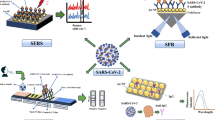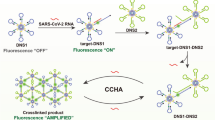Abstract
The miniprotein binder TRI2-2 was employed as an antibody alternative to build a single antibody-coupled TRI2-2 based gold nanoparticle-based lateral flow immunoassay (AT–GLFIA) biosensor. The biosensor provides high specificity and affinity binding between TRI2-2 and severe acute respiratory syndrome coronavirus 2 (SARS-CoV-2) variants of concern (VOCs) spike antigen receptor binding domain (S-RBD). It also enables rapid testing of wild-type (WT), B.1.1.7 (Alpha), B.1.351 (Beta), B.1.617.2 (Delta), P.1 (Gamma), and B.1.1.529 (Omicron) SARS-CoV-2 S-RBD and is at least ~ 16-fold more sensitive than conventional antibody pair-based GLFIA (AP–GLFIA). Besides, we developed a wireless micro-electrochemical assay (WMECA) biosensor based on the TRI2-2, which demonstrates an excellent VOCs testing capability at the pg mL−1 level. Overall, our results demonstrate that integrating miniprotein binders into conventional immunoassay systems is a promising design for improving the testing capabilities of such systems without hard-to-obtain antibody pair, complex reporter design, laborious signal amplification strategies, or specific instrumentation.
Graphical Abstract






Similar content being viewed by others
References
WHO Coronavirus (COVID-19) Dashboard. https://covid19.who.int
Fozouni P, Son S, De León D, Derby M et al (2021) Amplification-free detection of SARS-CoV-2 with CRISPR-Cas13a and mobile phone microscopy. Cell 184:323-333.e9. https://doi.org/10.1016/j.cell.2020.12.001
Frank F, Keen MM, Rao A et al (2022) Deep mutational scanning identifies SARS-CoV-2 Nucleocapsid escape mutations of currently available rapid antigen tests. Cell 185:3603-3616.e13. https://doi.org/10.1016/j.cell.2022.08.010
Najjar D, Rainbow J, Sharma Timilsina S et al (2022) A lab-on-a-chip for the concurrent electrochemical detection of SARS-CoV-2 RNA and anti-SARS-CoV-2 antibodies in saliva and plasma. Nat Biomed Eng 6:968–978. https://doi.org/10.1038/s41551-022-00919-w
Zhang T, Deng R, Wang Y et al (2022) A paper-based assay for the colorimetric detection of SARS-CoV-2 variants at single-nucleotide resolution. Nat Biomed Eng 6(8):957–967. https://doi.org/10.1038/s41551-022-00907-0
Borghei Y, Samadikhah HR, Hosseinkhani S (2022) Exploitation of N-gene of SARS-CoV-2 to develop a new rapid assay by ASOs@AuNPs. Anal Chem 94(39):13616–13622. https://doi.org/10.1021/acs.analchem.2c03544
Ding X, Li Z, Avery L et al (2022) pH-EVD: A pH-paper-based extraction and visual detection system for instrument-free SARS-CoV-2 diagnostics. Adv NanoBiomed Res 2(2):2100101. https://doi.org/10.1002/anbr.202100101
Gupta R, Gupta P, Wang S, et al (2023) Ultrasensitive lateral-flow assays via plasmonically active antibody-conjugated fluorescent nanoparticles. Nat. Biomed. Eng. 1–15. https://doi.org/10.1038/s41551-022-01001-1
Dolgin E (2020) Cancer-eating immune cells kitted out with CARs. Nat Biotechnol 38:509–512
Beggs AD, Caiado CCS, Branigan M et al (2022) Machine learning for determining lateral flow device results for testing of SARS-CoV-2 infection in asymptomatic populations. Cell Rep Med 3:100784. https://doi.org/10.1016/j.xcrm.2022.100784
Pavelka M, Van-Zandvoort K, Abbott S et al (2021) The impact of population-wide rapid antigen testing on SARS-CoV-2 prevalence in Slovakia. Science 372:635–641. https://doi.org/10.1126/science.abf9648
García-Fiñana M, Buchan IE (2021) Rapid antigen testing in COVID-19 responses. Science 372:571–572. https://doi.org/10.1126/science.abi6680
Chan KK, Dorosky D, Sharma P et al (2020) Engineering human ACE2 to optimize binding to the spike protein of SARS coronavirus 2. Science 369:1261–1265. https://doi.org/10.1126/science.abc0870
Lan J, Ge J, Yu J et al (2020) Structure of the SARS-CoV-2 spike receptor-binding domain bound to the ACE2 receptor. Nature 581:215–220. https://doi.org/10.1038/s41586-020-2180-5
Li Y, Ma M, Lei Q et al (2021) Linear epitope landscape of the SARS-CoV-2 Spike protein constructed from 1,051 COVID-19 patients. Cell Rep 34:108915. https://doi.org/10.1016/j.celrep.2021.108915
Jaimes JA, André NM, Chappie JS et al (2020) Phylogenetic analysis and structural modeling of SARS-CoV-2 spike protein reveals an evolutionary distinct and proteolytically sensitive activation loop. J Mol Biol 432:3309–3325. https://doi.org/10.1016/j.jmb.2020.04.009
Lu R, Zhao X, Li J et al (2020) Genomic characterisation and epidemiology of 2019 novel coronavirus: implications for virus origins and receptor binding. The Lancet 395:565–574. https://doi.org/10.1016/S0140-6736(20)30251-8
Li F, Hong J, Guan C et al (2023) Affinity exploration of sars-cov-2 rbd variants to mab-functionalized plasmonic metasurfaces for label-free immunoassay boosting. ACS Nano. https://doi.org/10.1021/acsnano.2c08153
Romagnoli A, D’Agostino M, Pavoni E et al (2023) SARS-CoV-2 multi-variant rapid detector based on graphene transistor functionalized with an engineered dimeric ACE2 receptor. Nano Today 48:101729. https://doi.org/10.1016/j.nantod.2022.101729
Wei-Wen Hsiao W, Sharma N, Le T-N et al (2022) Fluorescent nanodiamond-based spin-enhanced lateral flow immunoassay for detection of SARS-CoV-2 nucleocapsid protein and spike protein from different variants. Anal Chim Acta 1230:340389. https://doi.org/10.1016/j.aca.2022.340389
Zhang J, Li Y, Chai F et al (2022) Ultrasensitive point-of-care biochemical sensor based on metal-AIEgen frameworks. Sci Adv 8:eabo1874. https://doi.org/10.1126/sciadv.abo1874
Miller BS, Bezinge L, Gliddon HD et al (2020) Spin-enhanced nanodiamond biosensing for ultrasensitive diagnostics. Nature 587:588–593. https://doi.org/10.1038/s41586-020-2917-1
Liu S, Luo X, Shu R et al (2022) Engineered core–shell multifunctional nano-tracer in raman-silent region with highly retained affinity to enhance lateral flow immunoassays. Small 18:2204859. https://doi.org/10.1002/smll.202204859
Wang C, Wang C, Li J et al (2022) Ultrasensitive and multiplex detection of four pathogenic bacteria on a bi-channel lateral flow immunoassay strip with three-dimensional membrane-like SERS nanostickers. Biosens Bioelectron 214:114525. https://doi.org/10.1016/j.bios.2022.114525
Weiß LJK, Rinklin P, Thakur B et al (2022) Prototype digital lateral flow sensor using impact electrochemistry in a competitive binding assay. ACS Sens 7:1967–1976. https://doi.org/10.1021/acssensors.2c00728
Hamad EM, Hawamdeh G, Jarrad NA, et al (2018) Detection of human chorionic gonadotropin (hCG) hormone using digital lateral flow immunoassay. In: 2018 40th Annual International Conference of the IEEE Engineering in Medicine and Biology Society (EMBC). IEEE, Honolulu, HI 3845–3848
Panferov VG, Ivanov NA, Mazzulli T et al (2023) Electrophoresis-assisted multilayer assembly of nanoparticles for sensitive lateral flow immunoassay. Angew Chem Int Ed 62:e202215548. https://doi.org/10.1002/anie.202215548
Loynachan CN, Thomas MR, Gray ER et al (2018) Platinum nanocatalyst amplification: redefining the gold standard for lateral flow immunoassays with ultrabroad dynamic range. ACS Nano 12:279–288. https://doi.org/10.1021/acsnano.7b06229
Gao Z, Ye H, Tang D et al (2017) Platinum-decorated gold nanoparticles with dual functionalities for ultrasensitive colorimetric in vitro diagnostics. Nano Lett 17:5572–5579. https://doi.org/10.1021/acs.nanolett.7b02385
Sena-Torralba A, Álvarez-Diduk R, Parolo C et al (2022) Toward next generation lateral flow assays: integration of nanomaterials. Chem Rev 122:14881–14910. https://doi.org/10.1021/acs.chemrev.1c01012
Cao L, Goreshnik I, Coventry B et al (2020) De novo design of picomolar SARS-CoV-2 miniprotein inhibitors. Science 370:426–431. https://doi.org/10.1126/science.abd9909
Hunt AC, Case JB, Park Y-J et al (2022) Multivalent designed proteins neutralize SARS-CoV-2 variants of concern and confer protection against infection in mice. Sci Transl Med 14:eabn1252. https://doi.org/10.1126/scitranslmed.abn1252
Findlay JWA, Dillard RF (2007) Appropriate calibration curve fitting in ligand binding assays. AAPS J 9:29. https://doi.org/10.1208/aapsj0902029
Iwanaga M (2020) All-dielectric metasurface fluorescence biosensors for high-sensitivity antibody/antigen detection. ACS Nano 14:17458–17467. https://doi.org/10.1021/acsnano.0c07722
Kilic T, Gessner I, Cho YK et al (2022) Zwitterionic polymer electroplating facilitates the preparation of electrode surfaces for biosensing. Adv Mater 34:2107892. https://doi.org/10.1002/adma.202107892
Torrente-Rodríguez RM, Lukas H, Tu J et al (2020) SARS-CoV-2 RapidPlex: a graphene-based multiplexed telemedicine platform for rapid and low-cost COVID-19 diagnosis and monitoring. Matter 3:1981–1998. https://doi.org/10.1016/j.matt.2020.09.027
Liu H, Yang A, Song J et al (2021) Ultrafast, sensitive, and portable detection of COVID-19 IgG using flexible organic electrochemical transistors. Sci Adv 7:eabg8387. https://doi.org/10.1126/sciadv.abg8387
Ban DK, Bodily T, Karkisaval AG et al (2022) Rapid self-test of unprocessed viruses of SARS-CoV-2 and its variants in saliva by portable wireless graphene biosensor. Proc Natl Acad Sci 119:e2206521119. https://doi.org/10.1073/pnas.2206521119
Wu C, Chen Z, Li C et al (2022) CRISPR-Cas12a-empowered electrochemical biosensor for rapid and ultrasensitive detection of SARS-CoV-2 delta variant. Nano-Micro Lett 14:159. https://doi.org/10.1007/s40820-022-00888-4
Peng R, Pan Y, Li Z et al (2022) SPEEDS: A portable serological testing platform for rapid electrochemical detection of SARS-CoV-2 antibodies. Biosens Bioelectron 197:113762. https://doi.org/10.1016/j.bios.2021.113762
de Lima LF, Ferreira AL, Torres MDT et al (2021) Minute-scale detection of SARS-CoV-2 using a low-cost biosensor composed of pencil graphite electrodes. Proc Natl Acad Sci 118:e2106724118. https://doi.org/10.1073/pnas.2106724118
Cardoso AR, Cabral-Miranda G, Reyes-Sandoval A et al (2017) Detecting circulating antibodies by controlled surface modification with specific target proteins: application to malaria. Biosens Bioelectron 91:833–841. https://doi.org/10.1016/j.bios.2017.01.031
Funding
This work was partially supported by the Shanghai Science and Technology Biomedical Innovation Funds (19441904200) for financial support.
Author information
Authors and Affiliations
Corresponding author
Ethics declarations
Conflict of interest
The authors declare no competing financial interests.
Additional information
Publisher's Note
Springer Nature remains neutral with regard to jurisdictional claims in published maps and institutional affiliations.
Supplementary Information
Below is the link to the electronic supplementary material.
Rights and permissions
Springer Nature or its licensor (e.g. a society or other partner) holds exclusive rights to this article under a publishing agreement with the author(s) or other rightsholder(s); author self-archiving of the accepted manuscript version of this article is solely governed by the terms of such publishing agreement and applicable law.
About this article
Cite this article
Hao, L., Li, X., Liang, H. et al. Biosensors based on potent miniprotein binder for sensitive testing of SARS-CoV‑2 variants of concern. Microchim Acta 191, 38 (2024). https://doi.org/10.1007/s00604-023-06113-2
Received:
Accepted:
Published:
DOI: https://doi.org/10.1007/s00604-023-06113-2




